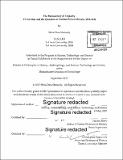| dc.contributor.advisor | Harriet Ritvo. | en_US |
| dc.contributor.author | Shmuely, Shira Dina | en_US |
| dc.contributor.other | Massachusetts Institute of Technology. Program in Science, Technology and Society. | en_US |
| dc.coverage.spatial | e-uk--- | en_US |
| dc.date.accessioned | 2018-03-02T22:20:01Z | |
| dc.date.available | 2018-03-02T22:20:01Z | |
| dc.date.copyright | 2017 | en_US |
| dc.date.issued | 2017 | en_US |
| dc.identifier.uri | http://hdl.handle.net/1721.1/113945 | |
| dc.description | Thesis: Ph. D. in History, Anthropology, and Science, Technology and Society (HASTS), Massachusetts Institute of Technology, Program in Science, Technology and Society, 2017. | en_US |
| dc.description | Cataloged from PDF version of thesis. | en_US |
| dc.description | Includes bibliographical references (pages 309-328). | en_US |
| dc.description.abstract | This dissertation examines the mutually reinforcing connections between science and law and their construction of pain in British regulation of animal experimentation. It investigates the Home Office's implementation of the Cruelty to Animals Act (1876), the first effort anywhere in the world to impose legal restrictions on vivisection, during the three decades following its enactment. The study ends in 1912 with the findings of a second Royal Commission that evaluated the workings of the Act. The Commission reaffirmed many of the Home Office polices regarding vivisection and their underlying premises. The Act mandated official supervision of scientific experiments that "calculated to give pain" to animal subjects. Implementing the Act therefore necessitated the identification and quantification of pain. This requirement created what I term the "bureaucracy of empathy," an attempt to systemize the understanding of animal suffering through administrative mechanisms. Practicing empathy was integral to some bureaucratic tasks, for example, attaching the right certificate to an inoculation experiment. Additionally, various factors including legal settings and scientific knowledge informed and situated this empathy with animals, when, for instance, an inspector drafted a report about mutilated monkeys while visiting a physiology laboratory. My analysis unravels that defining animal pain was often intertwined with the definition of an experiment. Law and science co-constitution of pain and experiments conditioned both the daily work of administering the law and the practices of experimenters. This dynamic led to the adoption of technologies such as anesthesia and pain scoring models, which provided legal-medical means to control pain in research and to ostensibly create a cruelty free experimental fact. A new pain-based ethical order was established, designed by law officers, civil servants, and court judges as much as by physiologists, remaking the relationships between experimenters, state representatives, and laboratory animals. | en_US |
| dc.description.statementofresponsibility | by Shira Dina Shmuely. | en_US |
| dc.format.extent | v, 330 pages | en_US |
| dc.language.iso | eng | en_US |
| dc.publisher | Massachusetts Institute of Technology | en_US |
| dc.rights | MIT theses are protected by copyright. They may be viewed, downloaded, or printed from this source but further reproduction or distribution in any format is prohibited without written permission. | en_US |
| dc.rights.uri | http://dspace.mit.edu/handle/1721.1/7582 | en_US |
| dc.subject | Program in Science, Technology and Society. | en_US |
| dc.title | The bureaucracy of empathy : vivisection and the question of animal pain in Britain, 1876-1912 | en_US |
| dc.title.alternative | Vivisection and the question of animal pain in Britain, 1876-1912 | en_US |
| dc.type | Thesis | en_US |
| dc.description.degree | Ph. D. in History, Anthropology, and Science, Technology and Society (HASTS) | en_US |
| dc.contributor.department | Massachusetts Institute of Technology. Program in Science, Technology and Society | |
| dc.identifier.oclc | 1023433126 | en_US |
